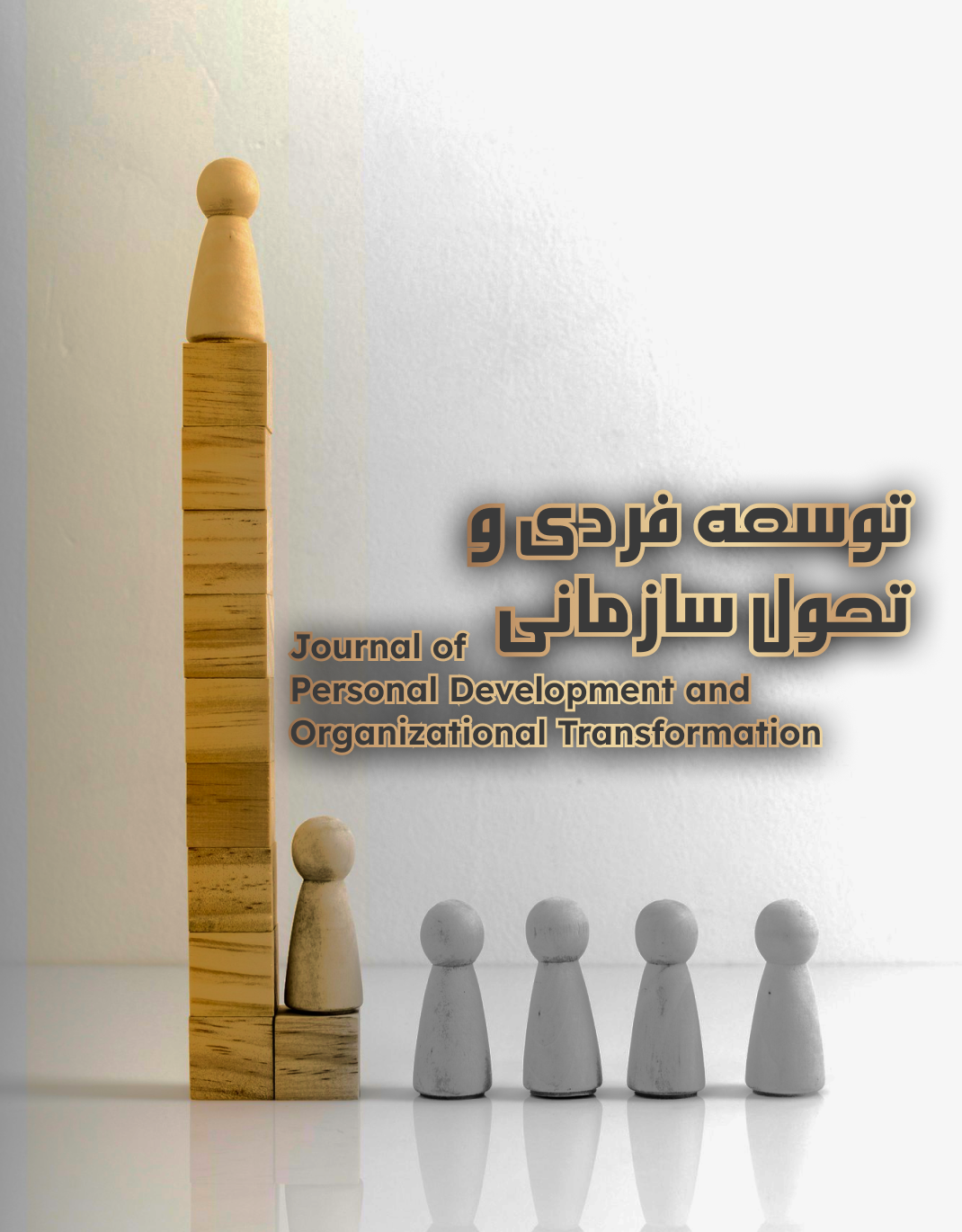Developing a Conceptual Framework for Managing Social Traps in Iranian Public Organizations
Keywords:
Social trap, multiple organizational dimensions, prevention strategies, organizational culture, imitative behaviorsAbstract
Considering the challenges faced by Iranian public organizations in confronting social traps—which lead to reduced productivity and diminished public trust—this study aims to design and present a comprehensive model for managing these traps. The proposed model seeks to identify influential factors and provide practical solutions to enhance decision-making processes and organizational interactions. This research adopts a qualitative approach using the grounded theory methodology. Data were collected through in-depth interviews with experts and subsequently analyzed. Purposeful and snowball sampling methods were employed to select participants. Initially, several key individuals in the fields of public administration, information technology, law, and social sciences—who were familiar with the concept of social traps—were selected as the initial core group. Based on their recommendations, other experts were identified and invited for interviews (total of 22 participants). The coding process was conducted in three phases: open coding, axial coding, and selective coding. To validate the research findings, Lincoln and Guba’s (1985) evaluation criteria—credibility, transferability, dependability, and confirmability—were applied. Inter-coder reliability was assessed using agreement between two coders, with the reliability level reaching 85 percent. Ultimately, the final model of the study was confirmed and validated through expert opinions. The findings revealed that managing social traps in Iranian public organizations requires attention to seven key dimensions: cognitive, behavioral, psychological-emotional, organizational, managerial, social, and ethical-value. By offering a comprehensive model for managing social traps, this research provides a significant innovation in analyzing this phenomenon within Iranian public organizations. Considering the multifaceted cognitive, behavioral, and organizational dimensions, the model presents novel and practical strategies for improving organizational interactions and enhancing transparency and efficiency in public institutions.
Downloads
References
Akbari Emami, S., Abedin, B., & Jami Pour, M. (2024). Strategic Consensus Challenges from the Perspective of Government Managers: Application of Social Network Analysis Methodology. Iranian Journal of Public Administration Studies, 7(1), 29-71. https://www.jipas.ir/&url=http:/www.jipas.ir/article_190203.html?lang=fa
Andina-Díaz, A., Feri, F., & Meléndez-Jiménez, M. A. (2023). The bureaucracy trap. Economics Letters, 228, 111166. https://doi.org/10.1016/j.econlet.2023.111166
Bazerman, M. H., & Tenbrunsel, A. E. (2011). Blind spots: Why we fail to do what's right and what to do about it. Princeton University Press. https://doi.org/10.1515/9781400837991
Berens, S. (2020). Opting for exit: informalization, social policy discontent, and lack of good governance. Latin American Politics and Society, 62(2), 1-28. https://doi.org/10.1017/lap.2019.58
Carvalho, S., Kurian, P. O., Carvalho, C., & Carvalho, F. K. (2023). Fostering leader feedback seeking at the workplace: The role of HRD practice. Advances in Developing Human Resources, 25(1), 57-66. https://doi.org/10.1177/15234223221137331
Coldwell, D. A. (2019). Negative influences of the 4th industrial revolution on the workplace: Towards a theoretical model of entropic citizen behavior in toxic organizations. International journal of environmental research and public health, 16(15), 2670. https://doi.org/10.3390/ijerph16152670
Cumming, G. S. (2018). A review of social dilemmas and social‐ecological traps in conservation and natural resource management. Conservation Letters, 11(1), e12376. https://doi.org/10.1111/conl.12376
Daliri, H. (2019). Future Studies of Employment and Unemployment with an Emphasis on General Employment Policies. Strategic and Macro Policies, 7(27), 346-371. https://doi.org/10.32598/JMSP.7.3.2
Erlingsson, G. Ó., Jónsdóttir, G. A., & Kristinsson, G. H. (2022). Does legitimacy mitigate corruption? The relevance of social traps in low-corruption contexts. International Journal of Public Administration, 45(14), 1027-1038. https://doi.org/10.1080/01900692.2021.1955926
Fornander, L., Laukkanen, K., Molin, I., Nilsson, L., & Berggren, P. (2023). Team communication patterns during real and simulated trauma resuscitation-a social network analysis. Ergonomics, 1-26. https://doi.org/10.1080/00140139.2023.2221000
Hadziahmetovic, N., & Salihovic, N. (2022). The role of transparent communication and leadership in employee engagement. International Journal of Academic Reserach in Economics and Management Sciences, 11(2). https://doi.org/10.6007/IJAREMS/v11-i2/14067
Hardin, G. (1968). The tragedy of the Commons. Science, 162(3859), 1243-1248. https://doi.org/10.1126/science.162.3859.1243
Hu, S., Ji, F., & Li, D. (2023). Impacts of Social Media Usage in Facilitating Social Commerce: The Roles of Social Support and Cultural Identity Change. International Conference on Human-Computer Interaction, Cham. https://doi.org/10.1007/978-3-031-35921-7_19
Inwang, I. U., Okponganam, G. E., Odohoedi, J. O., & Attat, N. T. (2024). Conflict Management Strategies and Administrative Effectiveness: Issues in Public Secondary Schools in Akwa Ibom State. International Journal of Multidisciplinary Innovative Research, 4(3), 73-81. https://journals.co.za/doi/abs/10.10520/EJC140929
Iqbal, J., Asghar, A., & Asghar, M. Z. (2022). Effect of despotic leadership on employee turnover intention: mediating toxic workplace environment and cognitive distraction in academic institutions. Behavioral Sciences, 12(5), 125. https://doi.org/10.3390/bs12050125
Khalili, K., & Fathi, M. (2024). A Meta-Analysis of Research on the Consequences of Transformational Leadership. Organizational Culture Management, 22(3), 259-273. https://jomc.ut.ac.ir/article_97587.html
Killingsworth, P., & Eschenbacher, L. (2018). Designing organizational structures: Key thoughts for development. The Bulletin of the American Society of Hospital Pharmacists, 75(7), 482-492. https://doi.org/10.2146/ajhp170657
Lamperski, R. J. (2018). Work Namaste: The importance of mattering at work, and how a leader can create an environment where employees feel they and their work matter University of Pennsylvania]. https://repository.upenn.edu/entities/publication/a460f6e3-6229-4727-8549-854b2df76992
Lazem, S., & Gracanin, D. (2010). Social traps in second life. 2010 Second International Conference on Games and Virtual Worlds for Serious Applications, https://doi.org/10.1109/VS-GAMES.2010.29
Manes, E., Shapira, D., & Tobol, Y. (2018). Traps and incentives. The BE Journal of Theoretical Economics, 18(2), 20160036. https://doi.org/10.1515/bejte-2016-0036
Mohammadzadeh, S., & Yarmohammadi Vasel, M. (2018). Preliminary estimation of the reliability and validity of the social trap scale. Social Cognition, 7(1), 160-143. https://sc.journals.pnu.ac.ir/article_4894.html
Molavi, Z., & Haji Naghi, M. (2024). Identifying the Factors Affecting the Occurrence of Intra-Organizational Stroke in Governmental Organizations of Qom Province. Organizational Culture Management Journal, 22(2), 141-160. https://journals.ut.ac.ir/article_93978.html
Naznen, F., Al Mamun, A., & Rahman, M. K. (2022). Modelling social entrepreneurial intention among university students in Bangladesh using value-belief-norm framework. Current Psychology, 1-18. https://doi.org/10.1007/s12144-022-04119-2
Nikitara, M., Dimalibot, M. R., Latzourakis, E., & Constantinou, C. S. (2024). Conflict Management in Nursing: Analyzing Styles, Strategies, and Influencing Factors: A Systematic Review. Nursing Reports, 14(4), 4173-4192. https://doi.org/10.3390/nursrep14040304
Parks, C. D. (2020). Social loafing in the management of social dilemmas Individual Motivation Within Groups. Academic Press. https://doi.org/10.1016/B978-0-12-849867-5.00008-2
Pollack, L., Munson, A., Zepeda, E., Culshaw-Maurer, M., & Sih, A. (2022). Variation in plastic consumption: social group size enhances individual susceptibility to an evolutionary trap. Animal Behaviour, 192, 171-188. https://doi.org/10.1016/j.anbehav.2022.07.010
Rahimzadeh, F., Shokoohi Fard, S., & Hazeri Niri, H. (2022). The Effect of Corruption on Financial Inclusion (Application of System Generalized Method of Moments Approach). Economic Modeling Quarterly, 16(57), 33-48. https://journals.iau.ir/article_692466.html
Rajabi Farjad, H., Mirsepasi, N., & Asadi, V. (2024). Identifying and prioritizing factors affecting organizational vitality. Iranian journal of management sciences, 19(73), 99-118. https://journal.iams.ir/article_420.html?lang=fa
Rasool, S. F., Wang, M., Tang, M., Saeed, A., & Iqbal, J. (2021). What a toxic workplace environment effects the employee engagement: The mediating role of organizational support and employee wellbeing. International journal of environmental research and public health, 18(5), 2294. https://doi.org/10.3390/ijerph18052294
Senge, P. M. (2006). The fifth discipline: The art and practice of the learning organization. Broadway Business. https://www.scirp.org/reference/referencespapers?referenceid=1122355
Sterman, J. D. (2000). Business Dynamics: Systems thinking and modeling for a complex world. MacGraw-Hill Company. https://www.researchgate.net/publication/44827001_Business_Dynamics_System_Thinking_and_Modeling_for_a_Complex_World
Tavakolian Ardakani, S. (2022). The Impact of Toxic Organizational Environments on Employee Engagement with Respect to the Mediating Role of Organizational Support and Employee Well-being. New Research Approaches in Management Sciences, 8(28), 1-12. https://jnraims.ir/browse.php?a_id=307&sid=1&slc_lang=fa
Volchik, V. V., Korytsev, M. A., & Maslyukova, E. V. (2018). Institutional traps and New Public Management in education and science. Управленец, 9(6), 17-29. https://cyberleninka.ru/article/n/institutional-traps-and-new-public-management-in-education-and-science
Downloads
Published
Submitted
Revised
Accepted
Issue
Section
License
Copyright (c) 2025 Sajad Toupaesfandyari (Author); Alireza Banagar; Davood Kia Kojouri, Azim Salahi Kojour (Author)

This work is licensed under a Creative Commons Attribution-NonCommercial 4.0 International License.







